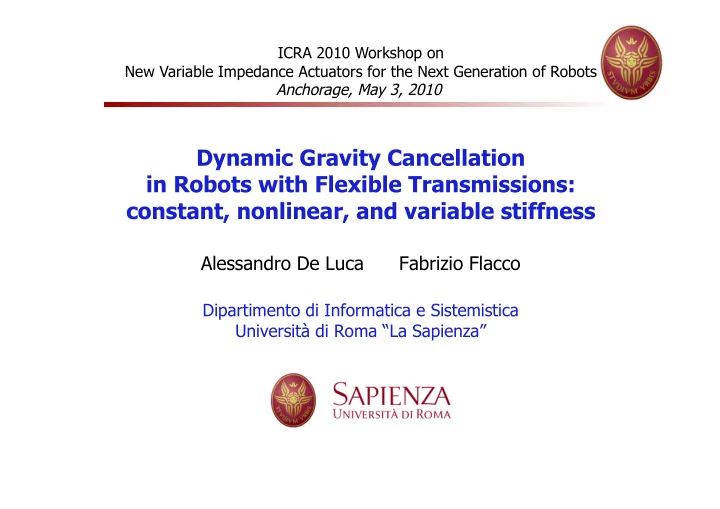

ICRA 2010 Workshop on New Variable Impedance Actuators for the Next Generation of Robots Anchorage, May 3, 2010 Dynamic Gravity Cancellation in Robots with Flexible Transmissions: constant, nonlinear, and variable stiffness Alessandro De Luca Fabrizio Flacco Dipartimento di Informatica e Sistemistica Università di Roma “La Sapienza”
Goals and motivations complete cancellation of gravity from the dynamics of a flexible robot by feedback control the robot should behave as in the absence of gravity or at least, some relevant output variables should match their behavior under no gravity both in static and dynamic conditions applicability to 1-dof and multi-dof devices zero-gravity field for unbiased robot reaction to collisions for safer human-robot interaction tasks controllers for regulation tasks without gravity constraints easier tuning of control gains no lower bound restrictions on gains and joint stiffness VIA Workshop @ ICRA’10 2
Collision detection and reaction De Luca, Albu-Schäffer, Haddadin: IROS06, IROS08 Collision Monitor continues residual r robot internal state and Collision Detected control input NO YES uses Normal Task deactivates Reaction Strategy Execution τ R τ “reflex” strategy in ZERO-GRAVITY NO external or τ R = K R r contact sensors VIA Workshop @ ICRA’10 3
Rigid robots trivial, due to collocation VIA Workshop @ ICRA’10 4
Flexible joint robots non-collocation of input torque and output ?? ?? constant or nonlinear joint stiffness VIA Workshop @ ICRA’10 5
Variable joint stiffness robots antagonistic actuation ?? VIA Workshop @ ICRA’10 6
Feedback equivalence gravity-loaded system gravity-free system feedback transformations (static state feedback + change of coordinates, both invertible) linear, controllable system ≈ linearizing outputs VIA Workshop @ ICRA’10 7
Flexible robots that are feedback linearizable robots with elastic joints linearizing output = link position (4) robots with joints having nonlinear flexibility robots with VSA-based actuation antagonistic VSA-II linearizing output = link position (4) + joint stiffness (2) DLR-VS joint ... VIA Workshop @ ICRA’10 8
Gravity cancellation in robots with elastic joints requires full state feedback VIA Workshop @ ICRA’10 9
Numerical results gravity cancellation for 1-dof elastic joint exact reproduction of same link behavior with and without gravity VIA Workshop @ ICRA’10 10
Numerical results gravity cancellation for 1-dof elastic joint different motor behavior torque comparison w.r.t. with and without gravity link-based gravity compensation VIA Workshop @ ICRA’10 11
A new PD-type regulator for robots with elastic joints Global asymptotic stability can be shown using a Lyapunov analysis under “minimal” sufficient conditions (also without viscous friction) i.e., no strictly and positive lower bounds VIA Workshop @ ICRA’10 12
Numerical results regulation of a one-link arm with EJ under gravity identical dynamic behavior of link still a different motor behavior in gravity-loaded system under PD + gravity cancellation and in gravity-free system under PD VIA Workshop @ ICRA’10 13
Numerical results regulation of a one-link arm with EJ under gravity total control torque profiles difference in link behavior in gravity-loaded system between dynamic gravity cancellation under PD + gravity cancellation and link-based compensation g(q) and in gravity-free system under PD VIA Workshop @ ICRA’10 14
Gravity cancellation in robots with nonlinear flexible joints – 1-dof case for all numerically solve for VIA Workshop @ ICRA’10 15
Gravity cancellation in robots with nonlinear flexible joints – 1-dof case closed-form solution in some particular cases, e.g., quadratic stiffness with VIA Workshop @ ICRA’10 16
Numerical results gravity cancellation in a joint with quadratic stiffness exact reproduction of same link behavior with and without gravity different motor behavior with and without gravity VIA Workshop @ ICRA’10 17
Gravity cancellation in robots with variable stiffness joints – 1-dof case symmetric, antagonistic arrangement total stiffness AND generically non-singular for VIA Workshop @ ICRA’10 18
Gravity cancellation in robots with variable stiffness joints – 1-dof case numerically solve VIA Workshop @ ICRA’10 19
Gravity cancellation in variable quadratic stiffness joint numerical solution in the particular case of (double) quadratic stiffness one of the two smooth branches, obtained with VIA Workshop @ ICRA’10 20
Numerical results gravity cancellation in joint with variable quadratic stiffness bang-bang (open loop) torques applied to the VSA joint torques sent to the VSA joint in the presence of gravity in the absence of gravity with dynamic gravity cancellation VIA Workshop @ ICRA’10 21
Numerical results gravity cancellation in joint with variable quadratic stiffness exact reproduction of same link behavior with and without gravity exact reproduction of same stiffness behavior with and without gravity VIA Workshop @ ICRA’10 22
Gravity cancellation for VSA-II driving a single link bi-directional antagonistic arrangement of two motors with a nonlinear flexible transmission by UniPisa Grashof neutral four-bar linkage + linear spring (two for each side) via feedback VIA Workshop @ ICRA’10 23
Numerical results gravity cancellation on the VSA-II joint exact reproduction of link behavior applied torques for gravity cancellation exact reproduction of stiffness behavior VIA Workshop @ ICRA’10 24
Conclusions achieved cancellation of gravity from link dynamics (and stiffness, if variable) of robots with flexible transmissions works even in highly dynamic conditions it is a by-product of FL (feedback linearization) but much simpler (especially in the multi-dof case) compromise between FL and energy-based Lyapunov methods allows the definition of natural torque-based reaction schemes to collisions also for VSA-based robots (as opposed to IROS’09) leads to novel regulation control designs without (larger than zero) lower bounds on gains and stiffness unifies the handling of robot stiffness in response to contacts, independently from gravity VIA Workshop @ ICRA’10 25
Recommend
More recommend